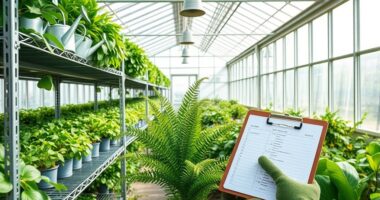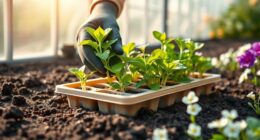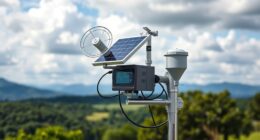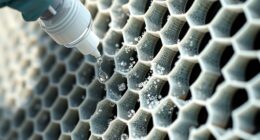To extend your greenhouse’s lifespan, choose weather-resistant materials like treated glass, polycarbonate, and galvanized steel. Conduct regular inspections to spot damage, clean surfaces gently, and maintain vents and seals. Make certain your foundation is sturdy and anchors are secure to handle wind and shifting soil. Protect moving parts with lubrication and reinforce the structure before storms or heavy snowfalls. Managing debris and external conditions also helps prevent premature wear. Continue exploring for more tips to keep your greenhouse durable over time.
Key Takeaways
- Use weather-resistant, high-quality materials like polycarbonate panels and galvanized steel for durability.
- Conduct regular inspections and clean the greenhouse to prevent material degradation and mold buildup.
- Ensure a sturdy foundation and reinforce anchors to withstand soil shifts and environmental stresses.
- Lubricate moving parts and secure the structure before storms or heavy snowfall to prevent damage.
- Maintain external surroundings by removing debris and controlling pests to reduce environmental wear and moisture issues.

Living a long, healthy life is possible when you make mindful choices every day. The same principle applies to your greenhouse structure. Properly caring for it guarantees it remains resilient and functional for years to come. One of the most critical aspects of longevity is understanding material durability. When selecting materials for your greenhouse, prioritize those that withstand weather, UV exposure, and daily wear. High-quality polycarbonate panels, treated glass, and galvanized steel frames tend to resist corrosion, cracking, and warping better than cheaper alternatives. Investing in durable materials means fewer repairs and replacements, saving you time and money over the long haul.
Choosing durable materials like polycarbonate, glass, and galvanized steel ensures your greenhouse’s longevity and resilience.
Equally important is establishing consistent maintenance routines. Regular inspections help you catch issues early before they escalate into costly problems. Check for damaged or loose panels, rusted frames, and worn seals around doors and vents. Clean your greenhouse regularly to prevent buildup of dirt, algae, and mold, which can compromise materials and reduce light transmission. Using appropriate cleaning solutions and gentle tools will preserve the integrity of your structure without causing damage.
Pay attention to ventilation components as part of your routine. Proper airflow prevents condensation, which can lead to mold growth and material deterioration. Ensure fans, vents, and louvers operate smoothly, and lubricate moving parts as needed. Additionally, consider the environment outside your greenhouse. Clear debris, fallen leaves, and weeds around the structure to reduce moisture accumulation and pest intrusion, both of which can accelerate wear and tear.
Another vital maintenance practice involves checking the foundation and anchoring systems. A sturdy base anchors your greenhouse against strong winds and shifting soil, preventing structural damage. Over time, soil may settle or shift, so reinforce or adjust anchors if necessary. Keep gutters and drainage systems clear of obstructions to avoid water pooling, which can cause rust or rot at the base of your structure.
Protecting your greenhouse from extreme weather conditions is also key to extending its lifespan. Cover handles, hinges, and other moving parts with lubricants to prevent rust. During storms or heavy snowfalls, ensure the structure is secure and consider removing or reinforcing fragile components. Implementing these proactive steps not only prolongs your greenhouse’s lifespan but also maintains an optimal environment for your plants.
Additionally, choosing projectors with high contrast ratios can significantly improve the durability of your viewing experience, especially in varying lighting conditions. Proper maintenance not only prolongs your greenhouse’s lifespan but also enhances your overall satisfaction with your setup.
Frequently Asked Questions
How Often Should I Inspect My Greenhouse for Damage?
You should inspect your greenhouse regularly to catch damage early. An inspection schedule of at least once a month helps with damage detection and prevents small issues from becoming costly repairs. After storms or extreme weather, do a quick damage check. Consistent inspections guarantee your greenhouse stays in top shape, allowing you to address problems promptly and extend its lifespan effectively.
What Are the Best Methods to Prevent Greenhouse Pest Infestations?
Prevention is like building a fortress around your greenhouse. You should apply pest resistant coatings to create a tough barrier against invaders. Regularly introduce beneficial insects for biological pest control, which naturally keeps pests in check. Keep your greenhouse clean, remove weeds, and seal any gaps. These methods work together to prevent infestations, ensuring your crops stay healthy and your greenhouse remains a thriving, pest-free environment.
Can Climate Changes Affect My Greenhouse’s Longevity?
Climate changes can definitely impact your greenhouse’s longevity. You need to focus on climate adaptability and weather resilience by choosing durable materials and designing for extreme conditions. Regular maintenance, installing protective features like windbreaks, and monitoring weather patterns help your structure withstand storms, temperature shifts, and other environmental stresses. By adapting to changing climates, you ensure your greenhouse remains functional and lasts longer, protecting your investment over time.
Are There Eco-Friendly Options for Greenhouse Maintenance?
You’re asking if eco-friendly options exist for maintaining your greenhouse. Absolutely! You can use sustainable materials for repairs and opt for eco-friendly cleaning products to keep it in top shape. These choices not only help the environment but also prolong your greenhouse’s lifespan. It’s a win-win situation, proving that you don’t have to choose between being green and maintaining your structure’s integrity. Stay committed, and your greenhouse will thrive longer.
How Does Proper Ventilation Impact Greenhouse Lifespan?
Proper ventilation greatly influences your greenhouse lifespan by enhancing ventilation efficiency and airflow control. When you guarantee good airflow, you prevent excess humidity and reduce the risk of mold, rot, and pests. This not only protects your plants but also preserves the structure itself. By maintaining ideal ventilation, you help your greenhouse stay durable and functional longer, ultimately extending its life and ensuring a healthy growing environment.
Conclusion
Now that you know these longevity tips, imagine stepping into your greenhouse years from now, still vibrant and strong. With each careful maintenance and smart upgrade, you’re not just protecting your structure — you’re revealing endless possibilities. But beware: the true test of your efforts lies ahead. Will your greenhouse stand the storms of time, or will unseen wear quietly chip away at its life? The choice is yours — nurture it well, and see what the future holds.









